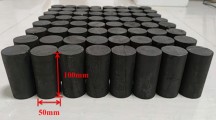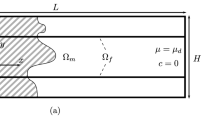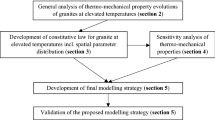The existing relations describing capillary inhibition in porous materials based on an ideal model and mercury porosimetry data are analyzed. It is shown that in transitioning from the hydraulic radius of an ideal model to the hydraulic radius of a capillary-porous material the tortuosity and narrowing (widening) of capillaries, the increase in temperature associated with sorption of water vapor, and the variation of the water viscosity as a function of the hydraulic radius of the capillary must be taken into account. The experimental data are used to make a quantitative evaluation of these effects. On this basis a relation is proposed for determining the hydraulic radius of the porous structure of the ceramic materials used for construction articles.

Similar content being viewed by others
References
E. W. Washburn, “Dynamics of capillary flow,” Phys. Rev., 17, 273 – 283 (1921).
D. Benavente, P. Lock, M. Angeles Garcia Del Cura, et al., “Predicting the capillary imbibition of porous rocks from microstructure,” Transport in Porous Media, 49, 59 – 76 (2002).
J. Schoelkopf, P. A. C. Gane, C. J. Ridgway, et al., “Practical observation of deviation from Lucas-Washburn scaling in porous media,” Colloids Surf. A: Physicochem. Eng. Aspects, 206, 445 – 454 (2002).
J. Schoelkopf, C. J. Ridgway, P. A. C. Gane, et al., “Measurement and network modeling of liquid permeation into compacted mineral blocks,” J. Colloid Interface Sci., 227, 119 – 131 (2000).
C. J. Ridgway, P. A. Gane, and J. Schoelkopf, “Effect of capillary element aspect ratio on the dynamic imbibition with porous networks,” J. Colloid Interface Sci., 252, 373 – 382 (2002).
G. N. Dul’nev and V. V. Novikov, Thermal Insulation in Industry: Theory and Calculation [in Russian], Stroiizdat, Moscow (2003).
G. N. Dul’nev and V. V. Novikov, Transport Processes in Nonuniform Media [in Russian], Énergoatomizdat, Moscow (1991).
J. Kubik, Przepływy wilgoci w materia 3 ach budowlanych, Politechnika Opolska, Opole (2000).
C. J. Ridgway, P. A. C. Gane, Abd El-Ghany el Abd, et al., “Water absorption into construction materials: comparison of neutron radiography data with network absorption models,” Transport in Porous Media, 63, 503 – 525 (2006).
C. J. Ridgway and P. A. C. Gane, “Dynamic absorption into simulated porous structures,” Colloids Surf. A: Physicochem. Eng. Aspects, 206, 217 – 239 (2002).
P. A. C. Gane, C. J. Ridgway, and J. Schoelkopf, “Absorption rate and volume dependency on the complexity of porous network structures,” Transport in Porous Media, 54, 79 – 106 (2004).
M. Raimondo, M. Dondi, D. Gardini, et al., “Predicting the initial rate of water absorption in clay bricks,” Construct. Building Mater., 23, 2623 – 2630 (2009).
EN ISO 9346:2007: Hygrothermal performance of building and materials; Physical quantities for mass transfer: Vocabulary (2007).
M. Janz, Methods of Measuring the Moisture Diffusivity at High Moisture Levels (Report TVBM 3076), University of Lund, Lund (1997); URL: http://lup.lub.lu.se/record/526308.
V. Nikitsin, B. Backiel-Brzozowska, and M. Bo3tryk, “Wpływ parametrow procesu wypalania na wskaŸniki podciągania kapilarnego wody w tworzywach ceramicznych,” Ceramica/Ceramics, 91, 587 – 592 (2005).
M. Karaglou, A. Moropoulou, A. Giakoumaki, et al., “Capillary rise kinetics of some building materials,” J. Colloid Interface Sci., 284, 260 – 264 (2005).
G. Cultrone, E. Sebastian, K. Elert, et al., “Influence of mineralogy and firing temperature on the porosity of bricks,” J. Europ. Ceram. Soc., 24, 547 – 564 (2004).
S. Roels, Modelling Unsaturated Moisture Transport in Heterogeneous Limestone, Author's Abstract of Doctoral’s Thesis, KU Leuven, Leuven (2000).
A. Kičaitè, R. Mačiulaitis, J. MalaiЉkienè, et al., “Structure and destruction of processes of building ceramic products,” in: Modern Building Materials, Structures and Techniques: Proc. of the 9th Intern. Conf., Vilnius, May 16 – 18, 2007, Vilnius (2007), pp. 65 – 66.
V. I. Nikitsin and B. Backiel-Brzozowska, “Methods of determination of liquid transfer coefficient in building materials,” Int. J. Heat Mass Transfer, 55, 4318 – 4322 (2012).
H. M. Künzel, Simultaneous Heat and Moisture Transport in Building Components: One- and Two-Dimensional Calculation Using Simple Parameters, Author’s Abstract of Doctoral’s Thesis, Fraunhofer Institute for Building Physics, Stuttgart (1995).
A. V. Afonin and V. I. Nikitin, “Calculation of the pore permeability of capillary-porous materials taking account of the flow of films and condensate,” Vestn. BrGTU: Stroit-vo Arkhitektura, No. 1, 34 – 40 (2003).
L. Shen and Z. Chen, “Critical review of the impact of tortuosity on diffusion,” Chem. Eng. Sci., 62, 3748 – 3755 (2007).
S. Roels, K. Vandersteen, and J. Carmeliet, “Measuring and simulating moisture uptake in a fractured porous medium,” Adv. Water Resources, 26, 237 – 246 (2003).
V. I. Nikitsin and B. Backiel-Brzozowska, “Determination of capillary tortuosity coefficient in calculations of moisture transfer in building materials,” Int. J. Heat Mass Transfer, 56, 30 – 34 (2013).
M. I. Nizovtsev, A. N. Sterlyagov, and V. I. Terekhov, “Propagation of a thermal front in capillary permeation of porous materials,” Polzunovskii Vestn., No. 1, 39 – 43 (2010).
Author information
Authors and Affiliations
Corresponding author
Additional information
Translated from Steklo i Keramika, No. 7, pp. 25 – 34, July, 2016.
Rights and permissions
About this article
Cite this article
Guryev, V.V., Nikitsin, V.I. & Kofanov, V.A. Determination of the Hydraulic Radius of the Porous Structure of Ceramic Materials. Glass Ceram 73, 258–265 (2016). https://doi.org/10.1007/s10717-016-9869-9
Published:
Issue Date:
DOI: https://doi.org/10.1007/s10717-016-9869-9




